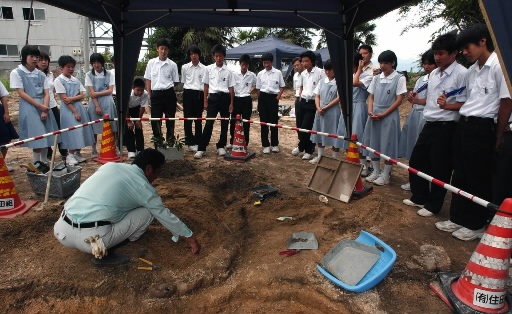Ninoshima Island, Awakening from Slumber, Part 5
Jun. 28, 2010
Facing the reality of war
by Kunihiko Sakurai and Aya Kano, Staff Writers
Fifty-nine years after the dropping of the atomic bomb [this series was originally published in July 2004], the remains of many atomic bomb victims are being found on Ninoshima, a small island off the coast of Hiroshima. The fact that they are just now being exhumed reveals the vast scope of the devastation wrought by the bombing. The brittle, dark brown bones are reminders of the long years that have elapsed, forgotten by the public. In this series the Chugoku Shimbun examines how we should remember the atomic bombing experience and how we should convey that experience to the next generation.
Just south of Ninoshima Junior High School an excavation of the remains of A-bomb victims is taking place. When students visited the site, the face of a complete skull that had surfaced seemed to be looking at them.
Some of the students frowned. But Madoka Mukae, 15, a third-year student at the school, continued to look at the remains. "To think I walked by here every day on my way to school…"
Kenji Sumida, 45, one of the workers participating in the excavation, began to explain the project to the students. "Five skulls were found here side by side," he said. "Their legs were laying over one another." Looking at the small hole, which measured about 60 cm square, the students gasped and then put their hands together in prayer.
The students expressed their feelings frankly, some saying how horrible they felt it was and others expressing sadness that the bodies had been buried in such a small space. Some wondered if there had been people of their own age among the victims. They laid an offering of flowers that they had brought with them.
Because of its location at the entrance to Hiroshima's port in Ujina, the island of Ninoshima was the site of many military facilities. In an excavation conducted in 1971 on the adjoining piece of land, the remains of an estimated 617 victims were exhumed. As a result, an increasing number of people have visited the island as it provides a good place to learn about both Japan's wartime aggression and the destruction brought about by the atomic bomb.
Ninoshima Kisen, which operates ferries to the island, sells a publication about Ninoshima aboard its ferries. The 96-page locally produced booklet includes photos taken during the war, a map showing war-related sites on the island, and accounts of their experiences by island residents.
The publication was edited by Yoshiyuki Hamamoto, 50, the company's office manager. It has been revised more than 10 times since 1988. It is popular with teachers and parents who lead student groups on visits to the island. "Above all, it gave me an opportunity to learn about peace," Mr. Hamamoto said.
Yoji Araki, 67, principal of the Ninoshima Gakuen School for the Disabled, visited Ninoshima Elementary School in late June after learning that remains had been found. He talked to the students about his own experiences and the island's history.
Because he had been evacuated to northern Hiroshima Prefecture along with other students, Mr. Araki was not exposed to the atomic bomb. But he lost his parents, who lived within 1 km of the hypocenter. "I don't want the children of today to experience that the hunger we suffered back then," he said repeatedly.
He often asks children what peace is. They offer various answers such as "a time of no war" or "the Japan of today." Mr. Araki firmly believes that there must be no more wars. "Once people die, that's it," he said.
Mr. Sumida, who talked to the junior high school students about the excavation, is president of the school's Parent-Teacher Association. At the time of the excavation in 1971 he was in junior high school. Those of his generation had experienced neither the war nor the atomic bombing, but he went to the site of the excavation at his own initiative. More than 30 years have passed since then. "Kids today don't seem to have much interest," he said in puzzlement, so he recommended that they visit the site.
There are only 33 students at Ninoshima Junior High School. After visiting the excavation site once or twice, they studied the atomic bombing and the island's history once again. Many of the students did not know why bones had been unearthed on the island.
The students all said that seeing the remains of the victims of the atomic bombing made them realize there really had been a war. "Before starting wars, people should think about how the countries of the world can get along," Madoka Mukae said decisively.
(Originally published July 20, 2004)








